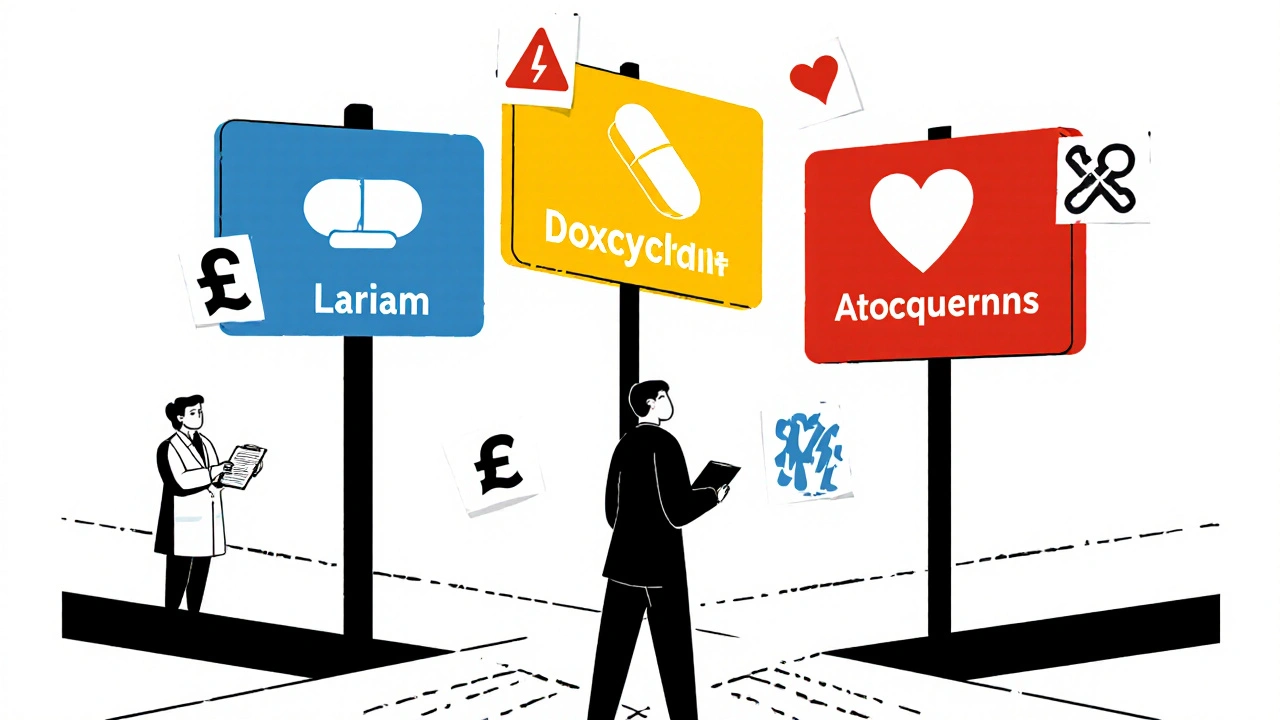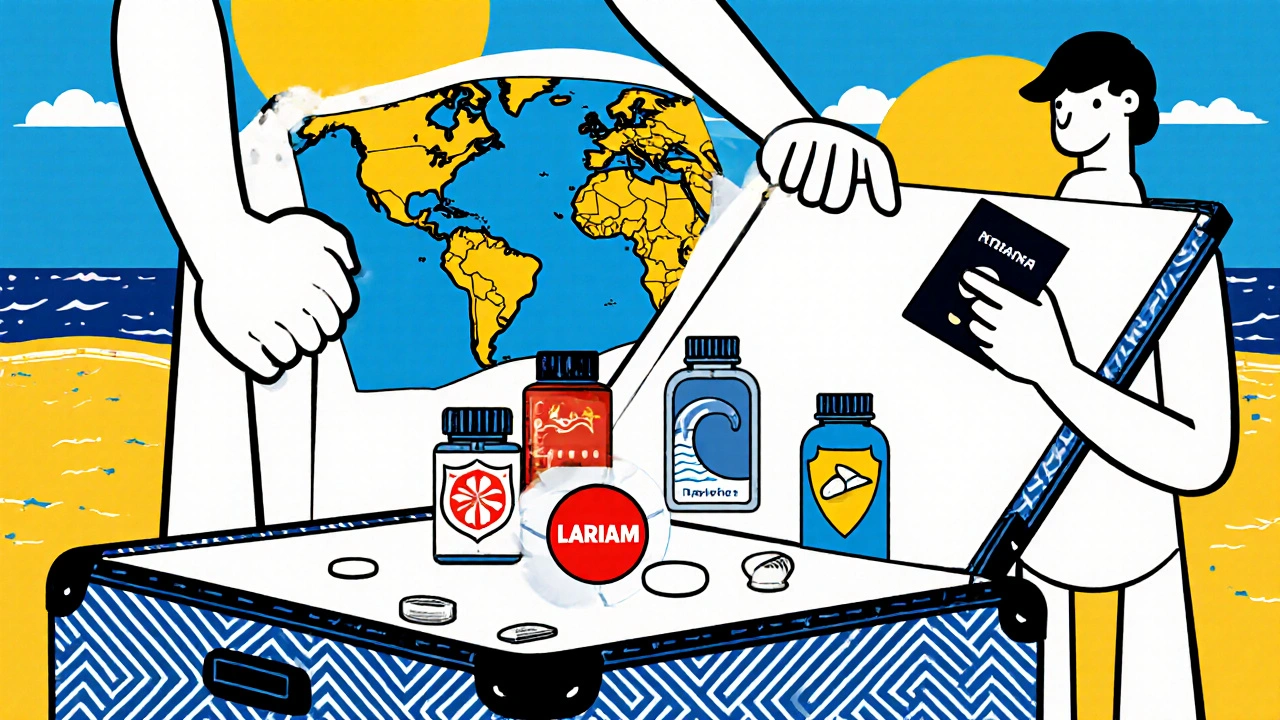Malaria Prophylaxis Selector
Personalized Malaria Prophylaxis Recommendation
This tool helps you select the most appropriate malaria prophylaxis based on your travel destination, medical history, and personal considerations.
Your Recommended Malaria Prophylaxis
Traveling to a malaria‑risk zone? Deciding which prophylactic medicine to pack can feel like you’re choosing a travel partner you’ll be stuck with for weeks. Lariam (Mefloquine) is a common pick, but there are several other options that promise fewer side effects or better coverage against resistant strains. This guide breaks down Lariam, weighs it against the main alternatives, and helps you pick the drug that fits your health profile and itinerary.
What is Lariam (Mefloquine) and how does it work?
Lariam is a synthetic antimalarial belonging to the quinoline‑methanol class. Its generic name, Mefloquine, was first approved by the U.S. Food and Drug Administration (FDA) in 1989 for both treatment and prevention of malaria caused by Plasmodium falciparum and Plasmodium vivax. The drug interferes with the parasite’s ability to digest hemoglobin, essentially starving it inside red blood cells.
For prophylaxis, the standard schedule is a 250 mg tablet taken weekly: one dose 2-3 days before entering a malaria‑endemic area, then weekly throughout exposure, and a final dose four weeks after leaving. Because it stays in the bloodstream for weeks, you only need one pill per week, which many travelers find convenient.
Why consider alternatives?
Even though Lariam is convenient, it carries a reputation for neuropsychiatric side effects-nightmares, anxiety, and in rare cases, depression or psychosis. When you factor in emerging drug‑resistant strains of Plasmodium falciparum, the picture gets more complex. That’s why doctors often recommend other chemoprophylactics based on your destination, medical history, and tolerance for side effects.
Overview of the most common alternatives
- Atovaquone‑proguanil (brand name Malarone) - a two‑drug combo taken daily. It has a short half‑life, so you must start 1-2 days before travel and continue 7 days after departure.
- Doxycycline - a tetracycline antibiotic taken daily. Works well against a broad range of malaria species but can cause photosensitivity and gastrointestinal upset.
- Chloroquine - once the gold standard, now limited to areas without documented resistance (e.g., most of Central America). Taken weekly, similar to Lariam.
- Primaquine - mainly used for relapse‑prevention of P. vivax and P. ovale. Requires testing for G6PD deficiency before use.
Side‑effect profiles at a glance
| Drug | Typical Dosage | Common Side Effects | Serious Risks | Contraindications |
|---|---|---|---|---|
| Lariam (Mefloquine) | 250 mg weekly | Headache, nausea, dizziness | Neuropsychiatric events (rare), cardiotoxicity | History of seizures, psychiatric disorders |
| Atovaquone‑proguanil | 1 tablet daily | Abdominal pain, loss of appetite | Severe skin reactions (rare) | Severe renal impairment |
| Doxycycline | 100 mg daily | Sun sensitivity, esophageal irritation | Intracranial hypertension (rare) | Pregnancy, children < 8 years |
| Chloroquine | 300 mg weekly | Itching, mild GI upset | Retinopathy with long‑term use | Known chloroquine‑resistant region |
| Primaquine | 30 mg daily (for relapse prevention) | Metallic taste, mild nausea | Hemolytic anemia in G6PD‑deficient patients | G6PD deficiency, pregnancy |
Efficacy and resistance trends
The World Health Organization (WHO) reports that Lariam remains >90 % effective against chloroquine‑sensitive P. falciparum strains but sees reduced efficacy where resistance mutations (e.g., Pfmdr1) are prevalent-particularly in Southeast Asia and parts of Oceania. Atovaquone‑proguanil shows similarly high efficacy (>95 %) across most endemic regions, partly because the two compounds act on different parasite pathways, making resistance less likely.
Doxycycline’s efficacy hovers around 94 % and is less impacted by genetic resistance, which is why many travel clinics recommend it for “high‑risk” zones. Chloroquine, however, is now only suitable where local surveillance confirms P. falciparum remains fully sensitive, such as certain areas of the Caribbean. Primaquine’s role is specialized: it clears dormant liver stages of P. vivax and P. ovale, preventing relapses months after exposure.

Cost and accessibility considerations
- Lariam: Generic mefloquine costs roughly £4‑£6 per tablet in the UK, making a 12‑week course about £48‑£72. Insurance often covers it, but some travellers cite difficulty obtaining a prescription due to psychiatric screening.
- Atovaquone‑proguanil: Brand‑name Malarone runs about £2‑£3 per tablet, so a 12‑week supply can exceed £200. Generic versions are emerging, lowering the price to around £1.50 per tablet.
- Doxycycline: About £0.30‑£0.50 per tablet, making it the most budget‑friendly option at ~£20‑£30 for a three‑month course.
- Chloroquine: Very cheap (≈£0.10 per tablet) when available, but limited by resistance.
- Primaquine: Approximately £0.70 per tablet; additional G6PD testing adds £50‑£70 to the total upfront cost.
From a logistics standpoint, weekly dosing (Lariam, Chloroquine) is easier to remember than daily pills, but daily regimens (Atovaquone‑proguanil, Doxycycline) reduce the risk of missed doses because you’re already in the habit of taking a medication each day.
Choosing the right prophylaxis for you
- Assess your destination. If you’re heading to a region with confirmed P. falciparum resistance to mefloquine (e.g., parts of Myanmar or Papua New Guinea), lean toward doxycycline or atovaquone‑proguanil.
- Review personal medical history. Prior psychiatric episodes, seizures, or heart rhythm problems tip the scale away from Lariam. Pregnancy or young children (<8 years) eliminate doxycycline and primaquine.
- Consider side‑effect tolerance. If you’re prone to sunburn or plan outdoor activities, avoid doxycycline’s photosensitivity. If you’re sensitive to gastrointestinal upset, atovaquone‑proguanil’s milder profile may be preferable.
- Factor in cost and insurance. Some insurers reimburse only specific drugs. Check your policy before committing.
- Plan the schedule. Remember the start‑and‑stop periods: Lariam and chloroquine require a 2‑week lead‑in, doxycycline a 1‑day lead‑in, and atovaquone‑proguanil a 2‑day lead‑in. Post‑travel continuation varies as well.
Ultimately, no single drug is universally “best.” The right choice balances efficacy against the specific parasite strains you’ll encounter, your health background, and practical factors like price and dosing frequency.
Frequently Asked Questions
Can I mix Lariam with other malaria drugs?
Mixing prophylactics is generally discouraged because of overlapping toxicities. If you need to switch drugs due to side effects, you should complete a wash‑out period (usually 4 weeks) before starting the new regimen.
How long after stopping Lariam do I remain protected?
Lariam stays in your system for about four weeks after the last dose, which is why the WHO advises taking a final tablet four weeks after leaving the endemic area.
Is Lariam safe for pregnant women?
Mefloquine is classified as pregnancy category B in the UK, meaning animal studies show no risk but human data are limited. Many clinicians prefer doxycycline (if beyond the first trimester) or atovaquone‑proguanil for pregnant travelers, after a risk‑benefit assessment.
Do I need a prescription for Lariam in the UK?
Yes. Because of its neuropsychiatric side‑effect profile, UK pharmacies require a prescription and a brief medical questionnaire before dispensing Lariam.
What should I do if I experience vivid dreams while taking Lariam?
Contact your healthcare provider immediately. In many cases, the doctor will switch you to an alternative drug rather than risk escalation of neuropsychiatric symptoms.
Choosing a malaria prophylaxis isn’t a one‑size‑fits‑all decision. By weighing Lariam’s weekly convenience against its side‑effect potential, and comparing it with daily options like doxycycline or the well‑tolerated atovaquone‑proguanil, you can land on a regimen that keeps you safe and comfortable throughout your adventure.
